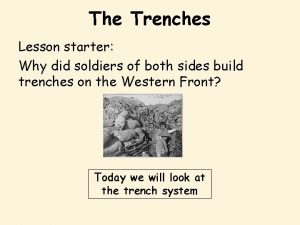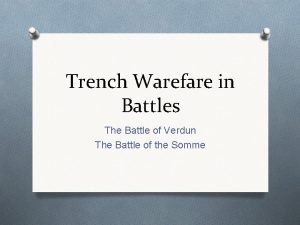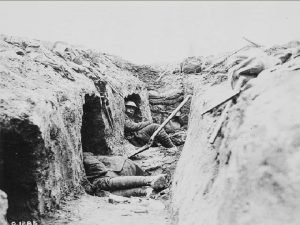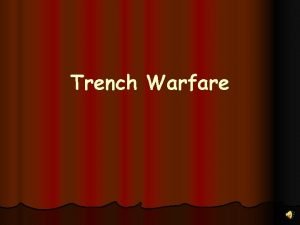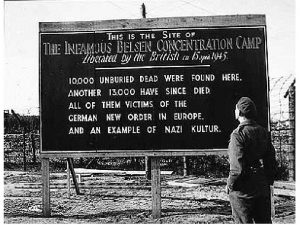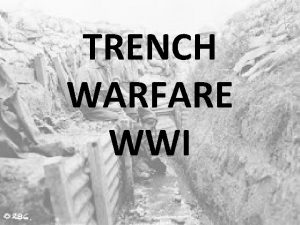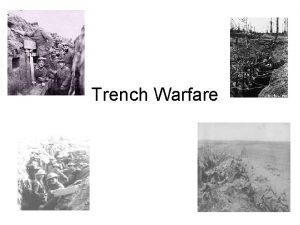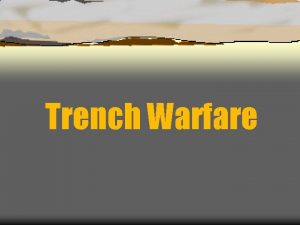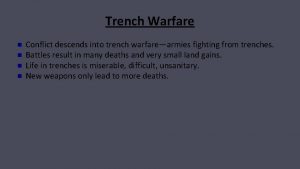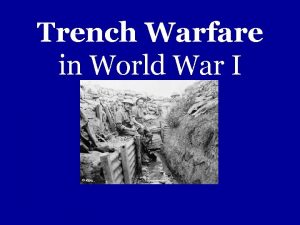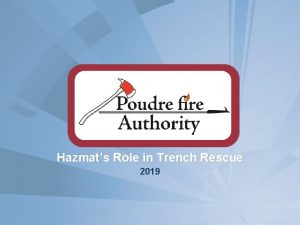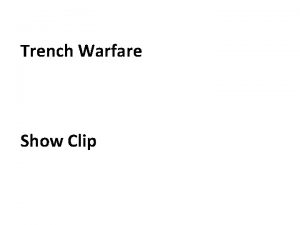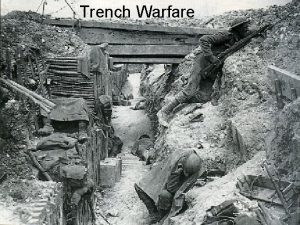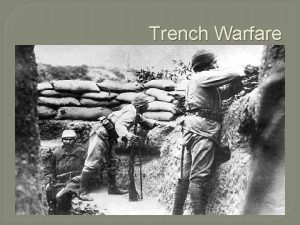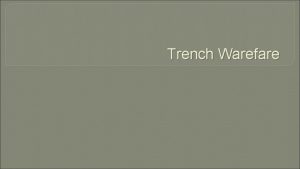Trench Routine Standto at Dawn Each dawn the
















- Slides: 16

Trench Routine “Stand-to” at Dawn • Each dawn, the usual time for an enemy attack, soldiers woke to “stand-to, ” guarding their front line trenches. Afterwards, if there had not been an assault, they gathered for inspections, breakfast, and the daily rum ration. Day-to-Day Work • Following morning stand-to, inspection, and breakfast, soldiers undertook any number of chores, ranging from cleaning latrines to filling sandbags or repairing duckboards. During daylight hours, they conducted all work below ground away from the snipers’ searching rifles. In between work fatigues, there was often time for leisure activities. Soldiers read, kept journals, wrote letters, or gambled.

Trench Routine Dangerous Nighttime Activity • Nighttime in the trenches was both the busiest and the most dangerous. Under cover of darkness, soldiers often climbed out of their trenches and moved into No Man’s Land, the blasted landscape separating the two armies. Here, work parties repaired barbed wire or dug new trenches. More aggressive operations involved patrolling for enemy activity or conducting raids to kill or capture enemy troops or to gather intelligence. A Steady Trickle of Death • Even in the so-called quiet moments, trench life witnessed a steady trickle of death and maiming. Outside of formal battles, snipers and shells regularly killed soldiers in the trenches, a phenomenon known as “wastage. ” This regular death toll ensured the need for constant reinforcements. In the 800 -strong infantry units, “wastage” rates were as high as 10 percent per month, or 80 soldiers killed or incapacitated.

Maintaining Morale Many factors helped persuade soldiers to fight. The bonds of friendship, loyalty and community based on shared experience and common dangers were principal among them, leading to a strong sense of group identity, especially among small groups. Training, firm discipline and strong leadership also motivated soldiers and, the threat of punishment helped keep soldiers in line. Military traditions and values were also important, even in citizen-armies like Canada’s, and the firm sense that most soldiers shared in the justness of their cause. The military understood many of the challenges to morale and the discomfort caused by life in the trenches. It tried to provide soldiers with the comforts necessary to sustain morale.

Maintaining Morale • Comfort from Home • Mail arrived daily from home. This was an important link back to loved ones, and soldiers retained an avid interest in the activities of family, friends, and community. Soldiers’ letters were censored in the trenches by their officers, and often at various commands behind the lines, but the fighting troops still communicated with home about their life in the trenches. • Care packages from home were also a periodic treat, and came filled with much-needed food, magazines, and clothes. Soldiers received cigarettes as part of a weekly ration, and most men smoked constantly. Soldiers often pleaded with those at home to send more cigarettes from their favourite brands.

Maintaining Morale • Rum as Reward, Medicine and Motivation • Army-issued rum was also important. When rum was available in the trenches, soldiers received a small dose in the morning and another at night. Rum was a reward, a medicine, and a combat motivator. Soldiers who had committed offences received no rum; those who had volunteered for trench raids or other dangerous missions received an extra share.

Effects of Low Morale • Desertion, when a soldier chose to abandon his military unit, was one possible indication of low morale, and often reflected excessive stress, mental break down, or “shellshock. ” Some soldiers deserted directly from the front, while others simply chose not to return to their unit from leave. The army feared a trickle of deserters could turn into a war-losing tide, if left unchecked by exploring causes, preventing opportunities, and maintaining morale. To combat desertion, the army imposed the strictest punishments, including death by firing squad.

Effects of Low Morale • Self-Inflicted Wounds • Self-inflicted wounds (SIWs) were another way in which soldiers attempted to escape the trenches, inflicting enough damage on themselves to escape front line service with a long hospital stay back in England. An SIW could take the form of a gunshot wound to the hand or foot, or rubbing chemically infected soil in one’s eyes. There were 729 recorded cases in the Canadian Expeditionary Force, and many more likely went undetected. Those under suspicion were typically sent to special SIW hospitals, subject to courtmartial, and liable to sentences that ranged from a few days of field punishment to imprisonment.

Effects of Low Morale • Malingering • Similar to SIWs, malingering included pretending to be ill, shell-shocked, or deliberately injuring oneself. Other malingerers exaggerated or prolonged their nervous symptoms once they were already out of the line. • Despite the strain on soldiers at the front, the number who tried to escape front-line service through these illegal actions was small.

Shell Shock • Shellshock was the blanket term applied by contemporaries to those soldiers who broke down under the strain of war. • A Poorly Understood Condition • The pace and intensity of industrialized warfare had profound effects on the human mind and body that were not related to wounds or physical injury. Poorly understood at the time and for many years afterwards, the crying, fear, paralysis, or insanity of soldiers exposed to the stress and horror of the trenches was often held by medical professionals to be the result of physical damage to the brain by the shock of exploding shells. Military authorities often saw its symptoms as expressions of cowardice or lack of moral character. Its true cause, prolonged exposure to the stress of combat, would not be fully understood or effectively treated during the war.

Shell Shock • Diagnosis and Treatment • Doctors diagnosed almost 10, 000 Canadians with shellshock during the war. Medical treatment ranged from the gentle to the cruel. Freudian techniques of talk and physical therapy helped many victims, while more extreme methods involved electric shock therapy. During the latter, patients were electrocuted in the hope of stimulating paralyzed nerves, vocal chords, or limbs. Shock therapy was more effective than Freudian techniques in returning soldiers to the front, with about two-thirds of all patients returned to the front. It is unknown how many relapsed when they re-entered combat. • Doctors knew very little of what we now term Post Traumatic Stress Disorder, and there were few treatment programs after the war for returned veterans who suffered from the mental trauma caused by war.

Trench Newspapers • A Safe Forum for Soldiers • Trench newspapers were a venue for common soldiers to give public expression to their thoughts. Popular Canadian soldier-produced papers including The Listening Post and The Dead Horse Corner Gazette satirized and ridiculed the hardships of war through articles, poetry, jokes, and cartoons. While military censors prohibited the publication of some information, trench newspapers could be surprisingly frank. They were a “safe” environment for soldiers to reveal their anger and antipathy to their hard life, although these messages were often couched in humourous jokes and puns. • There were over 30 different Canadian trench newspapers during the war. Few copies remain.

Trench Humor • Soldiers often turned to humour to alleviate the stress of life in the trenches. Jokes, puns, and satirical songs were a part of the soldiers’ oral culture. Much of the humour was lost on those outside the soldiers’ group, but it resonated with the soldiers and allowed them to cope with the strain of service and combat.


Trench Art • During leisure hours at the front, skilled soldiers created trench art from the remnants of war such as discarded bullets and shell casings. This “art” was not part of the official war art program. Its production was a popular pastime and many examples have survived the war. • The Creation of Trench Art • Soldiers made trench art at the front and behind the lines. Displaced civilians and Chinese labourers often augmented meager earnings by crafting and selling trench art as well. Because using government property for personal use was illegal, many trench artists did not sign their work leaving a large body of anonymous art.

Trench Art • Trench Art Comes Home • The soldiers viewed trench art as mementoes of service, and brought many pieces back to Canada after the war, where they remained in family homes for decades. • The Canadian War Museum has over 100 examples of First World War artifacts, and dozens more in its collection from the Second World War and recent military operations.

War Museum of Canada: Over the Top • Go through the online activity at the link below. Answer the questions from the handout Questions About the Story. • http: //www. warmuseum. ca/overthetop/
 Underground heat exchanger
Underground heat exchanger Cut and fill grid method
Cut and fill grid method Trench foot
Trench foot What is trench warefare
What is trench warefare Trench foot vs frostbite
Trench foot vs frostbite What is the picture
What is the picture Trench breadboard
Trench breadboard South sandwhich trench
South sandwhich trench Osha trench benching
Osha trench benching Trench warfare propaganda
Trench warfare propaganda Vultures poem
Vultures poem How did the treaty of versailles affect postwar germany?
How did the treaty of versailles affect postwar germany? Ocean basin profile
Ocean basin profile Mariana trench
Mariana trench Trench layering
Trench layering Mara sanz
Mara sanz Trench latrine adalah
Trench latrine adalah


